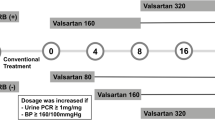Abstract
In the current study, we measured urinary angiotensinogen (AGT) through enzyme-linked immunoadsordent assay (ELISA) and analyzed its correlation with intrarenal renin–angiotensin system (RAS) activity in 128 chronic kidney disease (CKD) patients. Urinary and plasma renin activity, AGT, angiotensin II (Ang II) and aldosterone levels were also measured by radioimmunoassay (RIA) or ELISA in these participants. Further, the expression level of intrarenal renin, AGT, Ang II and Ang II receptors were examined by immunohistochemistry staining (IHCS) in 72 CKD patients. Their correlations with urinary AGT were also analyzed. We found that the urinary AGT level was positively correlated with hypertension (ρ = 0.28, P < 0.01), urinary protein (r = 0.38, P < 0.01), urinary Ang II (r = 0.29, P < 0.05), urinary type IV collagen (Col IV) (r = 0.56, P < 0.01), and was negatively correlated with estimated glomerular filtration rate (eGFR) (r = −0.28, P < 0.01), urinary sodium (r = −0.22, P < 0.05) and serum AGT (r = −0.27, P < 0.01). Multiple regression analysis indicated low serum AGT (P < 0.01), high urinary protein (P < 0.01), high urinary Ang II (P < 0.05) and high urinary Col IV (P < 0.01) were correlated significantly with high urinary AGT. Urinary AGT level was positively correlated with intrarenal expression level of AGT (ρ = 0.46, P < 0.01), Ang II (ρ = 0.56, P < 0.01) and Ang II type 1 receptor (ρ = 0.32, P < 0.01), as detected by IHCS. Together, these data suggest that urinary AGT might be a potential biomarker of intrarenal RAS and Ang II activities in CKD patients.




Similar content being viewed by others
Abbreviations
- AGT:
-
Angiotensinogen
- ELISA:
-
Enzyme-linked immunosorbent assay
- Ang II:
-
angiotensin II
- CKD:
-
Chronic kidney disease
- RAS:
-
renin–angiotensin system
- eGFR:
-
Estimated glomerular filtration rate
- RIA:
-
Radioimmunoassay
- IHCS:
-
Immunohistochemistry staining
- AT1R:
-
Ang II type 1 receptor
- PRA:
-
Plasma renin activity
- Col IV:
-
Type IV collagen
- BMI:
-
Body matrix index
References
Yamamoto T, Nakagawa T, Suzuki H, Ohashi N, Fukasawa H, Fujigaki Y, Kato A, Nakamura Y, Suzuki F, Hishida A (2007) Urinary angiotensinogen as a marker of intrarenal angiotensin II activity associated with deterioration of renal function in patients with chronic kidney disease. J Am Soc Nephrol 18(5):1558–1565
Darby IA, Sernia C (1995) In situ hybridization and immunohistochemistry of renal angiotensinogen in neonatal and adult rat kidneys. Cell Tissue Res 281(2):197–206
Kobori H, Alper AB Jr, Shenava R, Katsurada A, Saito T, Ohashi N, Urushihara M, Miyata K, Satou R, Hamm LL, Navar LG (2009) Urinary angiotensinogen as a novel biomarker of the intrarenal renin–angiotensin system status in hypertensive patients. Hypertension 53(2):344–350. doi:10.1161/HYPERTENSIONAHA.108.123802
Kobori H, Nishiyama A, Harrison-Bernard LM, Navar LG (2003) Urinary angiotensinogen as an indicator of intrarenal angiotensin status in hypertension. Hypertension 41(1):42–49
Casas JP, Chua W, Loukogeorgakis S, Vallance P, Smeeth L, Hingorani AD, MacAllister RJ (2005) Effect of inhibitors of the renin–angiotensin system and other antihypertensive drugs on renal outcomes: systematic review and meta-analysis. Lancet 366(9502):2026–2033
Wolf G (1999) Angiotensin II: a pivotal factor in the progression of renal diseases. Nephrol Dial Transpl 14(Suppl 1):42–44
Kobori H, Harrison-Bernard LM, Navar LG (2002) Urinary excretion of angiotensinogen reflects intrarenal angiotensinogen production. Kidney Int 61(2):579–585
Kobori H, Nishiyama A (2004) Effects of tempol on renal angiotensinogen production in Dahl salt-sensitive rats. Biochem Biophys Res Commun 315(3):746–750
Levey AS, Coresh J, Greene T, Stevens LA, Zhang YL, Hendriksen S, Kusek JW, Van Lente F (2006) Using standardized serum creatinine values in the modification of diet in renal disease study equation for estimating glomerular filtration rate. Ann Intern Med 145(4):247–254
Urushihara M, Kondo S, Kagami S, Kobori H (2010) Urinary angiotensinogen accurately reflects intrarenal renin–angiotensin system activity. Am J Nephrol 31(4):318–325. doi:10.1159/000286037
Hollenberg NK (2000) Implications of species difference for clinical investigation: studies on the renin–angiotensin system. Hypertension 35(1 Pt 2):150–154
Eddy AA (2000) Molecular basis of renal fibrosis. Pediatr Nephrol 15(3–4):290–301
Ellis D, Forrest KY, Erbey J, Orchard TJ (1998) Urinary measurement of transforming growth factor-beta and type IV collagen as new markers of renal injury: application in diabetic nephropathy. Clin Chem 44(5):950–956
Kobori H, Nangaku M, Navar LG, Nishiyama A (2007) The intrarenal renin–angiotensin system: from physiology to the pathobiology of hypertension and kidney disease. Pharmacol Rev 59(3):251–287
Velez JC (2009) The importance of the intrarenal renin–angiotensin system. Nat Clin Pract Nephrol 5(2):89–100. doi:10.1038/ncpneph1015
Nishiyama A, Konishi Y, Ohashi N, Morikawa T, Urushihara M, Maeda I, Hamada M, Kishida M, Hitomi H, Shirahashi N, Kobori H, Imanishi M (2011) Urinary angiotensinogen reflects the activity of intrarenal renin–angiotensin system in patients with IgA nephropathy. Nephrol Dial Transpl 26(1):170–177. doi:10.1093/ndt/gfq371
Favre L, Vallotton MB (1973) Kinetics of the reaction of human renin with natural substrates and tetradecapeptide substrate. Biochim Biophys Acta 327(2):471–480
Gould AB, Green D (1971) Kinetics of the human renin and human substrate reaction. Cardiovasc Res 5(1):86–89
Li XC, Navar LG, Shao Y, Zhuo JL (2007) Genetic deletion of AT1a receptors attenuates intracellular accumulation of ANG II in the kidney of AT1a receptor-deficient mice. Am J Physiol Renal Physiol 293(2):F586–F593
Li XC, Carretero OA, Navar LG, Zhuo JL (2006) AT1 receptor-mediated accumulation of extracellular angiotensin II in proximal tubule cells: role of cytoskeleton microtubules and tyrosine phosphatases. Am J Physiol Renal Physiol 291(2):F375–F383
Acknowledgments
This work was supported by research grant by the Ministry of Science and Technology of People’s Republic of China (2011BAI10B03) and young physician training program by Shanghai Health and Family Planning Commission.
Author information
Authors and Affiliations
Corresponding author
Rights and permissions
About this article
Cite this article
Zhang, Xy., Ding, Xq., Lv, Wl. et al. ELISA examining urinary angiotensinogen as a potential indicator of intrarenal renin–angiotensin system (RAS) activity: a clinical study of 128 chronic kidney disease patients. Mol Biol Rep 40, 5817–5824 (2013). https://doi.org/10.1007/s11033-013-2687-z
Received:
Accepted:
Published:
Issue Date:
DOI: https://doi.org/10.1007/s11033-013-2687-z




